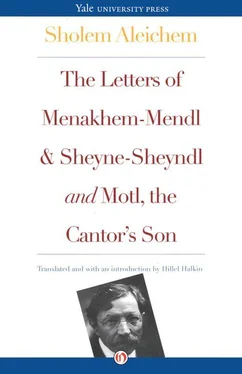It is his father’s death in Kasrilevke, ironically, that makes Motl the most carefree boy in Jewish literature, for with it he has inherited the best of both worlds: a mother and an elder brother who still provide him with love and security, and a life unburdened by a patriarchal religion and its demands of strict decorum, long hours of study, and scrupulous attention to ritual observance. From the little we know about Peysi, Motl’s father, he would have enforced these demands rigorously, since as a synagogue cantor (and one, it would seem, of stern temperament) he is a foremost member of the religious establishment of the shtetl. Motl’s comic refrain of “Lucky me, I’m an orphan” is thus truer than a boy his age can comprehend. Emancipated from a tradition he is not weighed down by like his brother Elye, he is ready for the freedom of America before he even knows what or where it is.
Just how old Motl is when his father dies is, like the wanderings of Menakhem-Mendl or the number of Tevye’s daughters, a question of variant texts. In the present translation his age is mentioned in Chapter 1, where his brother calls him “almost nine,” in Chapter 4, and in Chapter 19, in which he tells us he is the same age as his friend Bumpy, who is “nine going on ten.” But although this is the wording of the posthumous 1920 edition of Motl edited by Sholem Aleichem’s son-in-law Y. D. Berkovits, his Hebrew translator and a Hebrew author in his own right, it is not that of the 1911 edition edited by the author himself. There, Elye calls Motl a “five-year-old” and Bumpy is described as “seven going on eight.” “Nine” was Berkovits’ emendation, based on his, and possibly Sholem Aleichem’s reconsidered, judgment that Motl, as revealed to us by his language and perceptions, is too mature to be only five or even seven. Sholem Aleichem himself was clearly aware of this problem, because elsewhere he wavered over Motl’s age, making him six and eight in other passages in the serialized version of Part I that were deleted from the 1911 edition, and casting him as a boy of twelve or thirteen in a 1915 outline for a film script. [15] See Shmeruk, “Sippurei Motl ben he-hazan le-Shalom Aleikhem,” p. 315n. 24. Berkovits was extremely close to Sholem Aleichem and consulted him often when translating his work, so that it is quite possible that the subject of Motl’s age came up between them. In any case, I have accepted his emendation in my translation. It makes good sense, since a five-year-old Motl is not credible. For a brief discussion of how many daughters Tevye has, see the introduction to my translation of Tevye the Dairyman and The Railroad Stories (New York, 1987), pp. xviii — xix.
It has been argued that these differences were deliberate and reflect the passage of time in the story, which some critics have viewed as either indeterminate or spanning a very long period. [16] Dan Miron, for instance (“Bouncing Back,” pp. 130–133), calls the time frame in Motl “non-realistic” and “non-linear” and claims the book takes place during an “endless summer.” But although Miron is right that the book’s chronology is sometimes slapdash (as when, even though it supposedly takes place in 1907–1908, it refers to Woodrow Wilson as America’s president), this does not mean that no chronology was intended. On the other hand, a critic like Sidra DeKoven Ezrahi ( Booking Passage: Exile and Homecoming in the Modern Jewish Imagination, University of California Press, 2000, p. 123), does think that the passage of time in Motl is calculable — and that it adds up to nine years. How such a figure is arrived at is not clear, but its absurdity is only made possible by the accompanying assumption (one held by a number of Motl ’s critics) that Motl “doesn’t grow” psychologically in the course of the book and has no psychological age at all, so that, if he is five years old when the story begins and fourteen when it ends, this can be accepted as a literary given. But Motl does grow, his changing attitude toward religion being only one of several significant examples, and this growth is consistent with a boy who goes from being a little under nine to a little over eleven in the course of the book.
A careful reading of the text, however, shows that it is neither and that approximately two and a half years elapse from beginning to end: some six months from the death of Motl’s father on the holiday of Shavuos in late spring to his family’s departure from Kasrilevke in autumn, soon after the High Holy Days; a year of traveling to New York, which is reached several days after Yom Kippur; and another year in New York, where summer has ended as the story breaks off. Moreover, even if we allow for Motl’s growing older — a boy of five-plus in Chapter 1 could indeed have turned seven by Chapter 19—the fact remains that it is in the book’s opening paragraphs, when Motl is youngest, that his language is most unlike a child’s. Conceivably, this could be explained by reading his narrative, or parts of it, as an adult recollection of childhood — a construction that, while it does not harmonize well with most of the text, is supported by a number of passages. (Most notably the lines in the chapter “On Solid Ground” in which Motl speaks of his friend Mendl from the vantage point of many years later.) Alternately, Khone Shmeruk has proposed that Sholem Aleichem might have begun the first chapter of Motl as a third- rather than first-person narrative and neglected to simplify its language when he made the switch. [17] Shmeruk, “Sippurei Motl ben he-hazan,” p. 324. Shmeruk credits the Yiddish critic M. Viner with being the first to broach this theory.
One way or another, too much should not be made of such inconsistencies. Under the pressure of newspaper deadlines and bills to be paid Sholem Aleichem often wrote hurriedly, and the internal discrepancies resulting from this were not always eliminated in subsequent revisions.
Nor is the question of Motl’s age that crucial, because in the final analysis, it is not what he understands but what he sees and hears, often without understanding, that makes him our window on events. Although he is too young and buoyant to be worried about the things that trouble the adult world around him, he is also keenly curious, and our knowledge of this world and its complexities is the product of a partnership in which he observes and we interpret. It is only, for example, because Motl itches to “find out every secret in the world” that we overhear Pinye and Elye’s conversation in Kasrilevke about emigrating to America; but it is left to us to formulate what lies at the heart of the two men’s competitive relationship — namely, that while Elye prides himself on his enterprise and practicality, it is the absentminded Pinye who is the real innovator and initiator and Elye who gets dragged along behind him.
Motl and Pinye are natural allies. It is they, Motl tells us, who feel “made for America” and are sure they’ll “make it to the top there,” for they alone are sufficiently open to new experience to embrace it with both arms. Even before New York is reached, we know who in our party of travelers will Americanize the quickest, with the list headed by Motl, followed by Pinye, Elye, Brokheh, Taybl, and (although she will prove to have a resourcefulness of her own) Motl’s mother. Sholem Aleichem, a writer adept at making his main characters both believable individuals and representative types, was well aware that this reflected general categories. Young Jewish males, sociologically, were more eager to emigrate from eastern Europe than females, and less tradition-minded males like Pinye were the most so; upon arrival in the United States, acculturation proceeded in the same order. Unlike Elye, who continues to think in Old World terms, Pinye has cast these aside even before reaching “Ella’s Island.” It is he who supports going to work in a sweatshop as a first step up the economic ladder when Elye feels this is beneath his dignity; who throws himself into the garment workers’ strike that Elye holds back from; who first shaves off the beard that is a symbol of religious orthodoxy; who presses for going into business; who realizes that a corner stand is too small an operation; who grasps that aggressive advertising is the key to economic success in America. There may be something in him of Menakhem-Mendl, whose faith in the capitalist dream he shares, but Pinye understands the workings of capitalism as Menakhem-Mendl does not, and in him we see — although only in its earliest stages, since Motl, the Cantor’s Son breaks off before he can rise very far — the dream coming true.
Читать дальше












